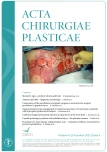Kombinovaná mykotická a bakteriální infekce u hlubokých popálenin dolní končetiny
Autoři:
Tresnerová I.; Fiamoli M.; Lipový B.; Bartošková J.
Působiště autorů:
Department of Burns and Plastic Surgery, University Hospital Brno and Faculty of Medicine, Masaryk University, Brno
Vyšlo v časopise:
ACTA CHIRURGIAE PLASTICAE, 63, 4, 2021, pp. 201-204
doi:
https://doi.org/10.48095/ccachp2021201
Zdroje
1. Hawksworth, DL. The fungal dimension of biodiversity: magnitude, significance and conservation. Mycological Research 1991; 95(6): 641–655.
2. Votava M., et al. Lékařská mikrobiologie speciální. 1. vyd. Brno: Neptun 2003: 211–217.
3. Kudlová E., et al. Hygiena výživy a nutriční epidemiologie. 1. vyd. Praha: Karolinum 2009: 251–256.
4. Ballard J., Edelman L., Saffle J., et al. Positive fungal cultures in burn patients: a multicenter review. J Burn Care Res. 2008; 29(1): 213–221.
5. Schofield CM., Murray CK., Horvath EE., et al. Correlation of culture with histopathology in fungal burn wound colonization and infection. Burns 2007; 33(3): 341–346.
6. Segal BH., Walsh TJ. Current approaches to diagnosis and treatment of invasive aspergillosis. Am J Respir Crit Care Med. 2006; 173(7): 707–717.
7. Pham AS., Tarrand JJ., May GS., et al. Diagnosis of invasive mold infection by real-time quantitative PCR. Am J Clin Pathol. 2003; 119(1): 38–44.
8. Brunton L., Knollman B., Hilal-Dandan R. Goodman & Gilman's the pharmacological basis of therapeutics. 12th ed. McGraw-Hill 2011; Chapter 57.
9. Horvath EE., Murray CK., Vaghan GM., et al. Fungal wound infection (not colonization) is independently associated with mortality in burn patients. Ann Surg. 2007; 245(6): 978–985.
10. Norbury W., Herndon DN., Tanksley J., et al. Infection in burns. Surg Infect. 2016; 17(2): 250–255.
11. Branski LK., Al-Mousawi A., Rivero H., et al. Emerging infections in burns. Surg Infect. 2009; 10: 389–397.
12. Matthaiou DK., Blot S., Koulenti D. Candida burn wound sepsis: the ‘‘holy trinity’’ of management. Intensive Crit Care Nurs. 2018; 46: 4–5.
13. Houschyar KS., Tapking C., Duscher D., et al. Antibiotic treatment of infections in burn patients – a systematic review. Handchir Mikrochir Plast Chir. 2019; 51(2): 111–118.
14. Sarabahi S., Tiwari VK., Arora S., et al. Changing pattern of fungal infection in burn patients. Burns 2012; 38(4): 520–528.
15. Murray CK., Loo FL., Hospenthal DR., et al. Incidence of systemic fungal infection and related mortality following severe burns. Burns 2008; 34(8): 1108–1112.
16. Capoor MR., Gupta S., Sarabahi S., et al. Epidemiological and clinico-mycological profile of fungal wound infection from largest burn centre in Asia. Mycoses 2012; 55(2): 181–188.
17. Howard PA., Cancio LC., McManus AT., et al. What’s new in burn-associated infections? Current Surgery 1999; 56 (7–8): 397–405.
Štítky
Chirurgie plastická Ortopedie Popáleninová medicína TraumatologieČlánek vyšel v časopise
Acta chirurgiae plasticae

2021 Číslo 4
- Metamizol jako analgetikum první volby: kdy, pro koho, jak a proč?
- MUDr. Lenka Klimešová: Multioborová vizita může být klíčem k efektivnější perioperační léčbě chronické bolesti
- Léčba akutní pooperační bolesti z pohledu ortopeda
- Příčiny a možnosti ovlivnění bolesti předního kolene po implantaci totální endoprotézy
Nejčtenější v tomto čísle
- Frontálně otevřený skus – diagnostika a léčba
- Léčba hypertrofických jizev frakčním CO2 laserem – hodnocení účinnosti a optimalizace léčebného protokolu
- Otrava kyanidem u pacientů s inhalačním poraněním – skrytá hrozba
- Moriartyho znamení – prediktor přihojení kožního štěpu
